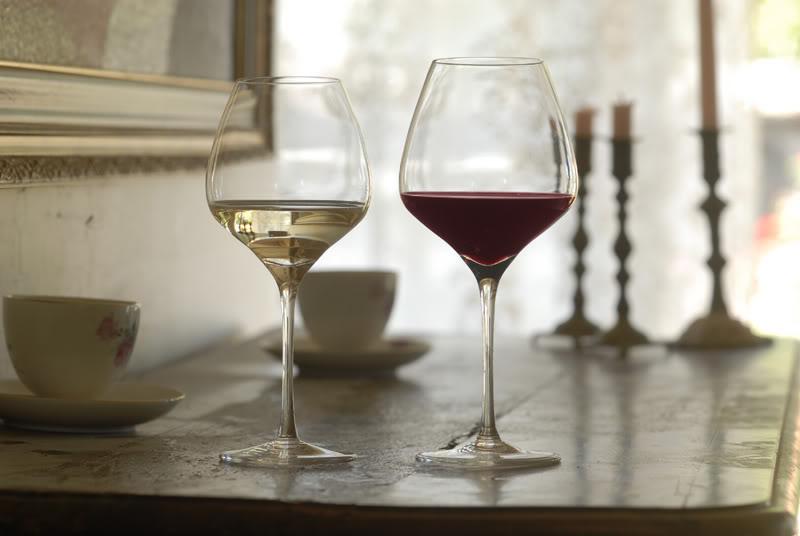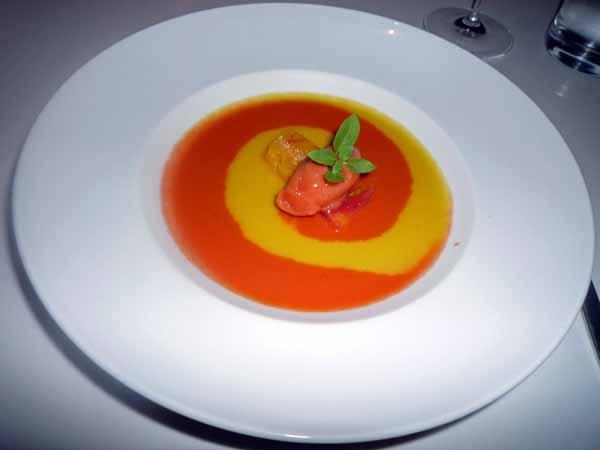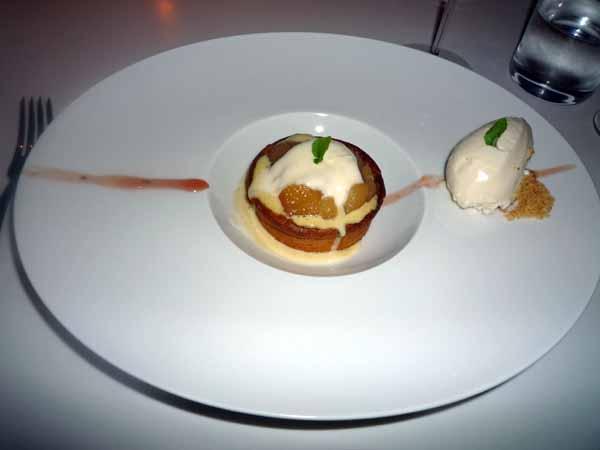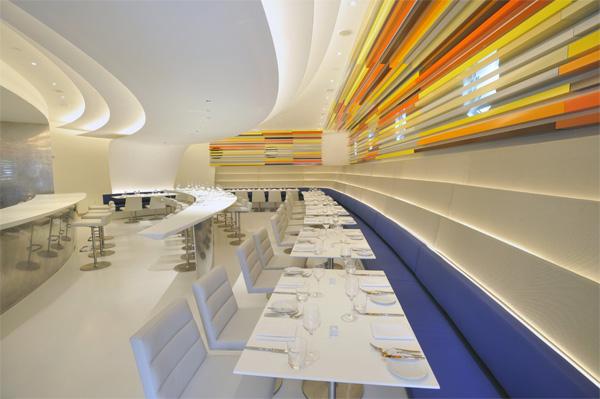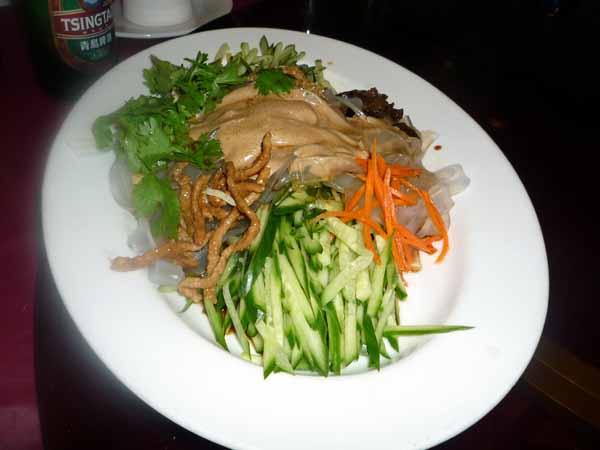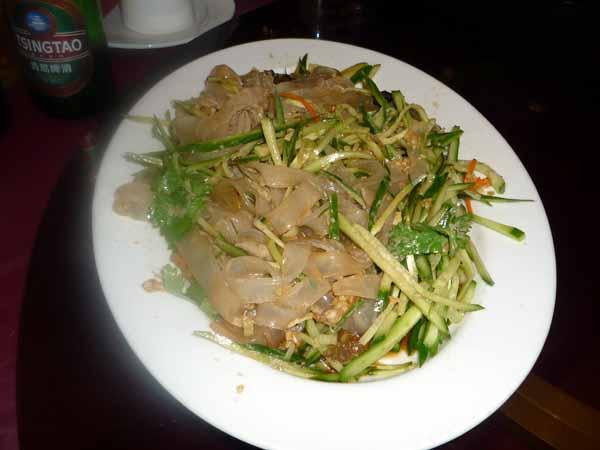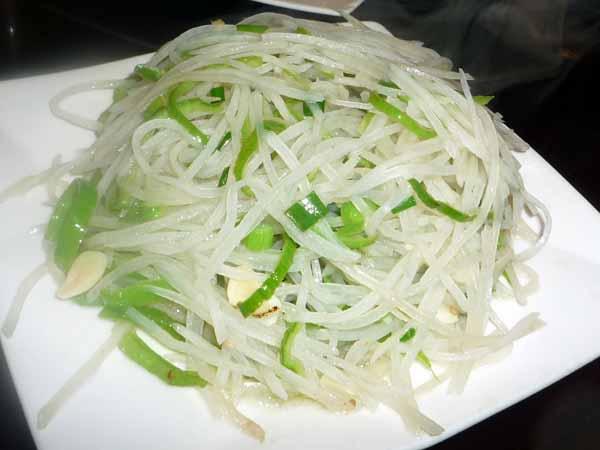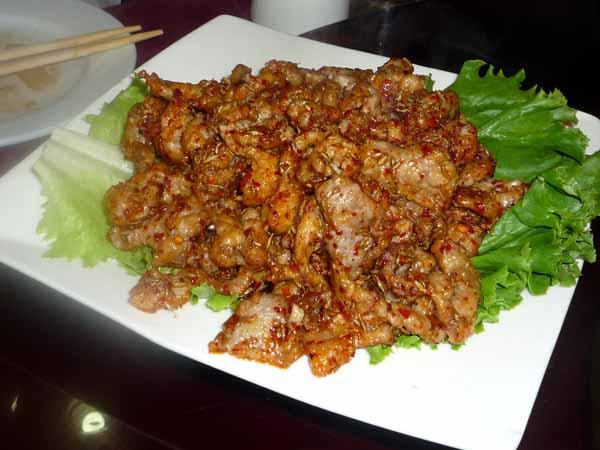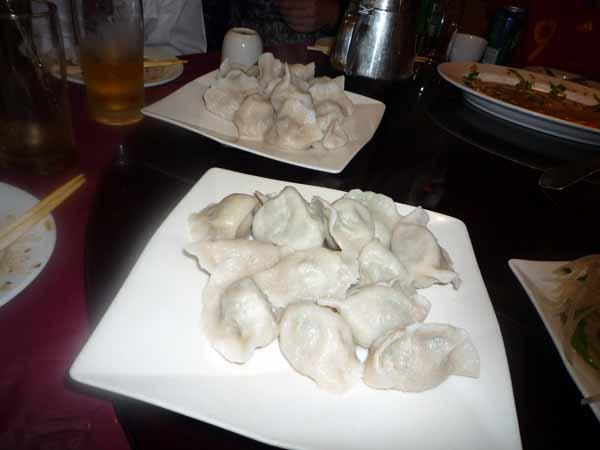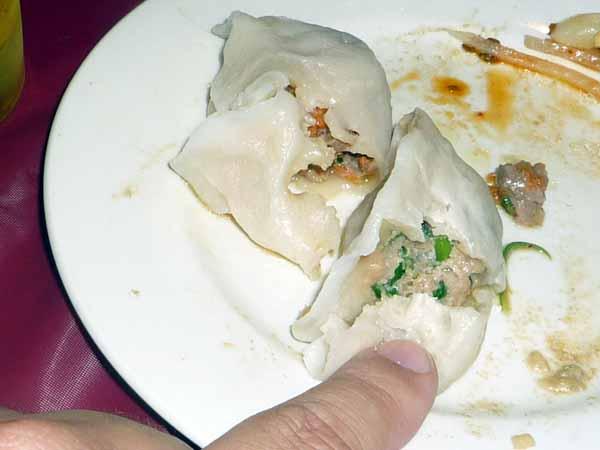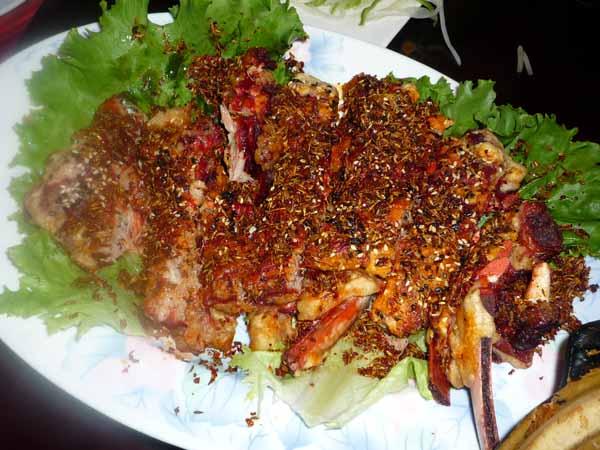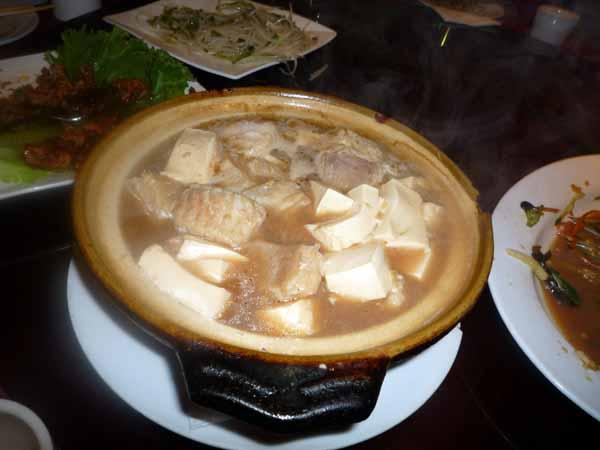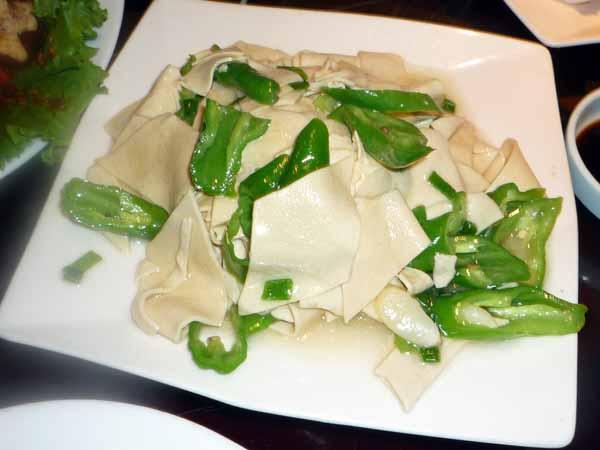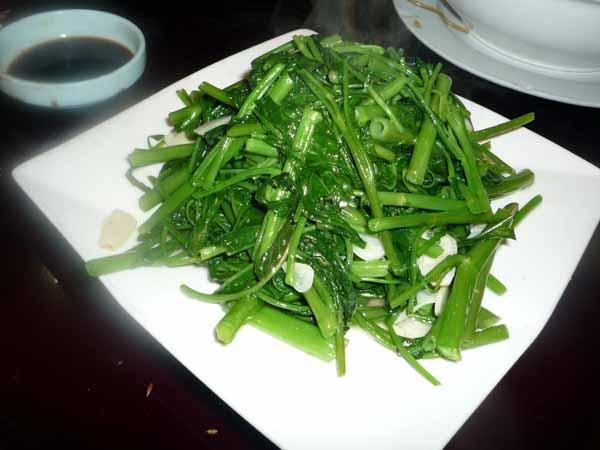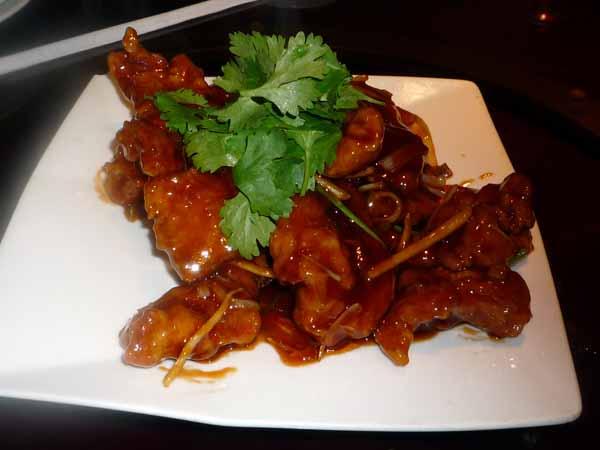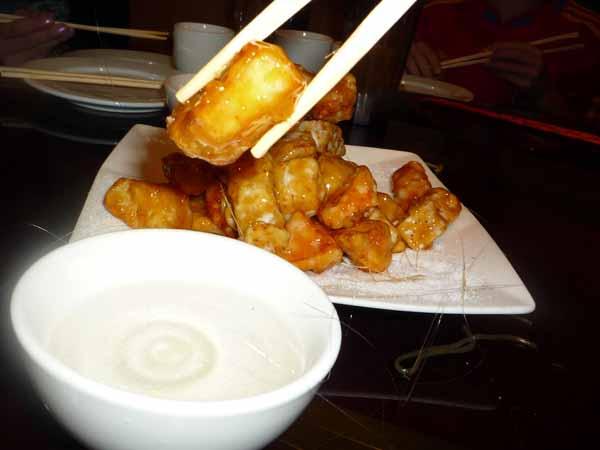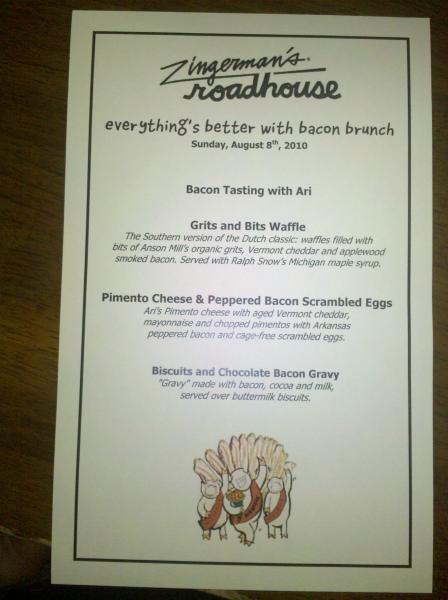-
Posts
28,458 -
Joined
-
Last visited
Content Type
Profiles
Forums
Store
Help Articles
Everything posted by Fat Guy
-
Just taste a little of the raw flour. Let it sit on your tongue. Self-rising, on account of the baking powder, should have a carbonation-like tingle. You can also, I imagine, put a spoonful in a glass of warm water and see if it reacts.
-
There has long been a trend among oenophiles toward specialization in wine stemware. Riedel, the leader of this trend, makes more than 40 different wine-glass shapes, each specifically targeted at a certain type of wine. If you don't use a glass custom-tailored to the wine you're serving, some would have us believe, the wine won't taste as good as it could. Manufacturers of wine glasses, of course, stand to benefit greatly if consumers believe this and seek out multiple sets of wine glasses, not just one for red and one for white. Whether or not there's something to it, the reality is that it's impractical for almost anyone -- consumer or restaurant -- to keep a full array of Riedel glasses on hand. My personal solution has been to keep two sets of Spiegelau glasses in inventory -- the Bordeaux glass and the Burgundy glass -- and to use the Bordeaux glass for all my whites and the Burgundy glass for all my reds. This isn't a perfect solution but works for most wines. Were one to devise the perfect two-glass solution it would involve a much more scientific process of averaging and tasting. Andrea Robinson (formerly Immer) recently spent three years doing just that. Robinson worked with the German glassware manufacturer Stölzle (a 200-year-old, major producer of lead-free crystal) to design The One. Or maybe it's really The Two. The idea is that she and her crystal-making counterparts have come up with just two glasses -- white and red -- that are intended to cover most any wine situation. They are pretty cool looking too: A little while back I went to a tasting hosted by Robinson, where we tried several wines in her new stems. I suppose there are wines that fall outside the range these glasses are ideal for, but we tasted from quite a few diverse bottles and the glasses flattered everything we tried. For comparison she put out the appropriate Riedel Sommelier-series glasses for each wine. I spent a lot of time going back and forth with the two types of glasses, in part because I was trying to be diligent, in part because I need to buy new glasses soon, and in part because I never know very many people at wine events. There were subtle differences in some instances but overall I think The One performed as well as the Riedel glasses in general, better in a couple of cases, and only slightly less well in one case. Certainly I experienced nothing to justify the expense and space requirements of having more than two types of glasses. The lips of the glasses are very thin, which I think helps -- to me the thickness of crummy wine glasses is their main drawback. The glasses are, for lack of a more creative description, crystal clear. The fairly steep slope of the sides helps collect aromas effectively. They're definitely nice to hold and drink from. Robinson and Stölzle also added various reinforcing compounds to the crystal to make the glasses break-resistant. You can't hurl them at a brick wall, but they are more tolerant of dishwashers and getting knocked around than normal glasses. I clinked a couple of them together aggressively about a dozen times and hit one against a table pretty hard and nothing happened. The glasses are not expensive. Through retail channels they run in the neighborhood of $10 a stem. You can get boxes of 4 right now from some Macy's stores for about 40 bucks (US). Apparently the glasses are also being sold, minus the fancy retail packaging, to the industry for closer to $5 per stem. I'll have to figure out how to tap into that supply line. There's a lot more information on Robinson's website here. At some point I'll try to pick up a bunch of these things so I can talk more about them.
-
I attended kind of a weird press event tonight. The invitation read: I'm so culturally illiterate that not only had I completely missed the news that a restaurant called the Wright opened in the Guggenheim museum last year (even though there was a huge story in the Times and the place won a Beard Award for design), but also it took me a night's sleep to figure out why they called it the Wright (duh, because of Frank Lloyd Wright, that guy who designed the Guggenheim). All this despite the fact that for 19 years I lived almost around the corner from the place. Also, the invitation came from the Guggenheim's PR people, who I don't normally deal with because they're not restaurant PR people, but the woman handling the account and I have a good friend in common and an invitation worked its way to me. I was curious enough to go. What was the purpose of the event, you ask? I'm not exactly sure. I think maybe just to remind media people about the restaurant. These were mostly not food-media people, though. I only recognized one person there: Bret Thorn from Nation's Restaurant News, who manages to be everywhere. He and I were the two token ugly guys. Most of the rest of the attendees were gorgeous fashion/lifestyle-media types. The meal was literally just a bowl of gazpacho and a peach tart. So I took only these two photos: I must say, the gazpacho was outstanding and little scoop of sorbet atop a tomato slice really elevated the dish. It was enough to make me take notice. The peach tart was also excellent. It turns out the chef, Rodolfo Contreras, is one of those journeyman chefs who has worked everywhere, including for David Bouley, Christian Delouvrier, and Rick Moonen. He has put together a very nice menu that is interesting enough to make me want to go back for a fuller meal. For example, in a million years I wouldn't have imagined that an Upper East Side museum restaurant (Restaurant Associates, of course) would have on offer dishes like "Roast suckling pig, aged balsamic Port glaze, summer cherries, mustard espresso emulsion," or "Sardine and piquillo pepper terrine, black olive caramel, shallot vinaigrette." For those who care about such things, every plate of food I saw come out of the kitchen was quite beautiful. They are currently running a "geometric prix fixe" menu made up of dishes with designs inspired by the Kandinsky exhibition, which is ending in a couple of weeks. And the tiny room (less than 60 seats even if you include the bar) is very attractive, designed by a fellow named Andre Kikoski in a style that is a more contemporary than the Guggenheim's design but flows naturally from it. I didn't take this photo; it's from the PR company. But really, isn't this the coolest looking restaurant? I'll report back once I've had a more substantial meal. Menus and such at http://www.thewrightrestaurant.com and they are on OpenTable.
-
Cascade Complete is certainly the best, and at full retail is probably a quarter a load more than if you go to Costco and get a gigantic thing of their generic stuff. That adds up, so it may be worth exploring alternatives. I imagine it would be possible to reverse engineer something that would be as effective as Cascade Complete. I wonder if you just added a little bleach to Kirkland's stuff if it would work -- I'm pretty sure it's the bleach that makes the difference with Cascade Complete. Maybe someone knows for sure.
-
Hooters.
-
I was assured by someone with experience/expertise that the pallid color was correct. The thing is, I've had that dish in several variants ranging from pallid to more colorful and I've never liked it. The Chinese have done amazing things with so many ingredients but not, in my opinion, with potatoes.
-
I had dinner at a Dongbei place in New York last night and posted a report here.
-
This is definitely a cuisine worth exploring. A couple of the dishes we had tonight were absolutely exquisite -- among the best Chinese dishes I've ever had. Others ranged from excellent to mediocre. We started with "Country style green bean sheet jelly." As with several dishes on the menu, it's quite impossible to figure out what it is from the description. As far as I can tell the "green bean sheet jelly" description refers to cold mung bean noodles. It's "country style" I suppose because it contains shredded pork, cucumbers, carrots, and wood ear mushrooms. The dish comes out as a pretty composition on the platter. Our server then took the dish away and tossed it with a sauce the most prominent feature of which was enough wasabi-type oil to pretty much ruin the dish. If I had this one to do over again I'd insist they go light on the sauce. I'm not sure anybody would listen -- communication with the waitstaff is extremely limited -- but I'd try. The first home run of the evening was the restaurant's rendition of cumin lamb. This dish has become popular around town at the Sichuan places. Fu Run's version was significantly more tender than any other I've had, with more restrained seasoning. I can't imagine this dish gets any better. I've had the stir-fried shredded potato dish in various types of Chinese restaurants and never liked it very much. I just can't relate to the Chinese penchant for undercooked potato. This version was better than most but still not to my liking. We had two types of boiled dumplings: lamb-carrot and pork-leek. Both were well executed but the lamb-carrot was the more remarkable of the two. I tried to photograph the insides of each but the photo is kind of gross looking. Sorry. The highlight of the evening, and the reason we came to the restaurant in the first place (because we saw it mentioned in the Times article I linked to above), was the "Muslim lamb chop." I haven't seen this dish anywhere else. Huge lamb ribs, braised, broiled and encrusted with whole cumin seeds. We got two orders. This dish is good enough on its own to make this place a destination restaurant. "Fish with tofu in casserole." Unremarkable. Tofu skin with hot green peppers, listed on the menu as "Dried tofu w. fresh hot pepper." The peppers were barely hot at all -- the cuisine of this region, or at least this restaurant, is only mildly spicy even when it's billed as spicy -- but the dish was quite good. One person at the table proclaimed he could "eat it all day." "Chicken w. mushroom and vermicelli." I ordered this on Shalmanese's say-so and it was great. It was kind of overshadowed by the seasonings in the lamb dishes but I could have just this dish as a meal. It's a little labor intensive because the chicken is hacked up on the bone, but the broth with its hit of five spice is delicious. "Sauteed Chinese watercress w. garlic." Way overcooked. I saw the same dish go out to a few tables, sometimes looking bright green and delicious and sometimes looking overcooked like ours. "Fried pork in orange sauce." Along the lines of orange chicken or orange beef, but not sticky and gross like the American-Chinese version. We ordered this because we saw it going to another table and it looked and smelled irresistible, which it turned out to be. Finally, we had the "mixed" selection from the "sweet dishes" section of the menu. What I observed is that when white people order this dish they bring it as a dessert course, whereas when Asian people order it they bring it as part of the main meal with all the other dishes. This is an instance of reverse discrimination for which I'm appreciative: I wouldn't want this dish as anything other than dessert. It's also the most enjoyable Chinese dessert I've had, even though it may or may not be a dessert. Chunks of cooked taro, sweet potato, apple and banana come coated in a molten sugar syrup. A bowl of water comes on the side. You take a piece and dip it in the cold water, which causes the sugar coating to seize up and become a crisp-chewy candy shell. The apple pieces appealed most to my Western palate, whereas the taro and sweet potato pieces lacked enough sweetness to work for me. Although there was or was supposed to be banana in there, I didn't get a piece. Service was friendly and painfully slow. There's a small private room in the back of the restaurant where they were having whatever is the Northeastern Chinese equivalent of a bat mitzvah, complete with a pink cake. This seemed to suck up a lot of waitstaff and kitchen resources. There doesn't appear to be anyone in the front of the house with enough English to offer ordering advice, so you just have to get what you get and hope for the best. Overall it was an uneven meal but the highlights were quite high. Assuming the good dishes are consistently good, and that there are several other good dishes on the large menu, it should be possible to put together an amazing meal there. The restaurant is located at 40-09 Prince Street in Flushing. They do take reservations, which are a good idea if you plan to dine at peak dinner hours (7-9pm). Phone is 718 321 1363.
-
I did my due diligence on google with various blogs, forums and news articles, in order to generate a list of dish candidates. I was just thinking maybe one of the faithful had the inside line. I'll report back after dinner.
-
There has been a semi-recent flurry of press activity around the emergence of several Northeast Chinese restaurants in Flushing. This Times article from February sums up the phenomenon: http://www.nytimes.com/2010/02/10/dining/10chine.html?_r=1&pagewanted=all I'm trying to get a handle on these places. Tonight I'm headed out to Fu Run. Has anybody been, and if so do you have any advice to offer?
-
Health-motivated substitutions tend to be the worst. They also are often presented out of context. Sure, there are some recipes out there where substituting two egg whites for a whole egg will work. But there are others where that substitution will wreck the outcome. Ditto skim milk for whole milk, whole-wheat flour for white flour, etc.
-
Those look really good. If I may say a word in defense of tomato sauces, I do think there are plenty of good reasons why people like them so much. I think a tomato-sauce rut can possibly be explained by a lack of variation in tomato-sauce methodology. There's a lot you can do with tomato sauce. Just last night, we had dinner with some new people and she made a tomato sauce with three variants of tomatoes: whole plum tomatoes from a can, halved fresh cherry tomatoes, and chopped sun-dried tomatoes (packed in oil), plus lots of garlic, basil, and parsley. There was a lot of flavor complexity in the sauce. To me what's boring is the same old Italian-American "gravy" aka marinara sauce. Tomato sauces like what I had last night are plenty interesting.
-
It's really the saute-type dry-ish cooking methods that are difficult to express and standardize as simple numbers. Crepes and pancakes are essentially baked. They're cooked in pans but it probably makes most sense to call the process "stovetop baking" or "pan baking" or something like that. As a result, pan-surface temperature is a relevant measure just as it is with oven baking. An infrared thermomether can make a huge difference there, just as a properly calibrated oven can with regular baking. There are variables other than temperature at play, but temperature is the big one. With wet cooking (at sea-level atmospheric pressure) there's the automatic regulatory process that limits the boiling point to 100c. I've noticed that in Europe they often have numbers 1-10 on the range dials. Are these standardized in some way?
-
But the speed at which a pot of water came up to the boil isn't all that relevant to cooking performance. Boiled/simmered/poached foods come out pretty much the same no matter the equipment. It's the dry cooking methods where the variance is so significant.
-
I'm not sure range temperature would be the relevant measure for standardization, since one cooks on cookware not a range. What matters most is the surface temperature of the cookware, at least for sauteing and other dry cooking methods. That means an infrared thermometer would have to become standard home-kitchen equipment in order for us to be able to communicate in a fully objective manner about this issue. Even then, thermal capacity of cookware is going to affect performance once a given surface temperature is established.
-
My suggestion is that you start making pasta primavera. It's a great way to use whatever vegetables you have, both fresh and frozen. You can prep the vegetables while the water is coming to a boil, saute the vegetables while the pasta is cooking, then assemble everything in the saute pan once the pasta is drained. While pesto doesn't exactly meet the criteria laid out in the opening post, it compensates by being easily freezable. You whip up a batch in the food processor and then you have it for single-serving use whenever.
-
There are some commonalities among the world's major cuisines that could be fodder for columns. For example, most every cuisine has some variant of the dumpling. People might be interested in reading about dumplings around the world. That sort of thing.
-
The salient feature of kosher fish sauce is that it contains no shellfish or other un-kosher fish. So it tends to be made with 100% anchovies. That, and it is made under rabbinic supervision. I know of one restaurant -- not a kosher restaurant -- that uses kosher fish sauce because it offers the assurance that it won't be problematic for customers with shellfish allergies.
-
One nice thing about Cleveland is that it's drivable in a day from New York City. Maybe next year will finally be the year I bring the whole family.
-

Things from the professional kitchen that every home cook should have
Fat Guy replied to a topic in Kitchen Consumer
There are stainless sheet pans, for example: http://www.webstaurantstore.com/half-size-stainless-steel-bun-sheet-pan/327901318SS.html -
My feeling is that if you can get good asparagus and you don't mind spending the time peeling, you get far more flavor and a superior (less fibrous) texture from thick asparagus.
-
Torakris will be making tempura.
-
Apples, cherries, grapes, cucumbers, bell peppers, potatoes, zucchini and eggplant should be firm. Although it's ideal to buy fragrant, ripe stone fruits, it's rare for me to find those retail. I generally buy them hard and try to find nice, unblemished ones. They usually ripen well on the counter. A lot of things do: avocados, bananas, melons even tomatoes ripen nicely. Sometimes you get a specimen that's so bad it rots before it ripens, though.
-
A lot depends on what you eat. We for example would be lost without a salad spinner. For others it would be useless. For extended travel where we have to equip a kitchen we generally roll with a cast-iron skillet, because you can cook most things in it, it's a better utensil that anything you'll find in a rental, and there's no harm done if you wreck it or lose it. It's nice to have a couple of plastic cafeteria trays to carry things around on. For all the knives, scissors, microplanes, turners, etc., it's nice to have a chef's "toolkit" so they're all in one place and you can just pick up and go.
-
As the flock returns to the diaspora, we should start seeing more photos and reports. In the meantime, a quick mention of our final event: the bacon brunch at Zingerman's Roadhouse. We started the brunch with the pleasure and honor of a bacon tasting led by Ari Weinzweig, founder of Zingerman's. Ari is one of the most influential figures in American gourmet food. He has written a whole book on bacon. We tasted Edwards, Benton's, Neuske's and an Arkansas pepper bacon. Ari's basic contention is that bacon is the American analog to olive oil in Italy: present in most regions and cuisines, high and low, in amazing variety that only the locals really understand and appreciate. Tasting these four excellent bacons side-by-side really underscored that bacon is a many-splendored product. The Benton's bacon was both my favorite and the most controvesial: it has such a strong, smoky flavor that it's challenging to eat straight, and would totally overwhelm a lot of things (e.g., fish) as an ingredient, but the flavors are immense. Ari likened it to a big Barolo or many-year-aged cheddar, which I thought was astute. I can see why Neuske's is so popular in the gourmet-food world: it's delicious but also very accessible. The Arkansas pepper bacon was also great. The Edwards was the least interesting to me, but still quite a lot better than standard supermarket junk. Here's Ari running the tasting: This is the menu: After we tasted bacon we had eggs with bacon, waffles with bacon, biscuits with chocolate-bacon gravy, and a surprise dessert bonus of bacon gelato. Chris and Karen Hennes and I had a little time before our flights, and we had missed Friday's field trip to Dearborn, so we hit a couple of Dearborn spots after brunch: the Super Greenland Market and the Shatila Bakery. Both pretty impressive. The Korean Americans have H-Mart and the Indian Americans have Patel Brothers, but they've got nothing on the Arab American superstores in Dearborn. Now I'm sitting in the Detroit airport thinking about next year. I'm looking forward to another one. Thanks everyone for coming from near and far and especially to Tammy for her leadership.


